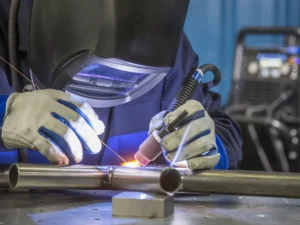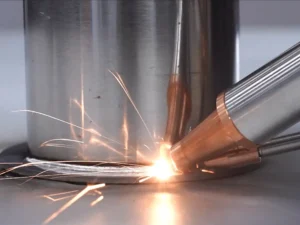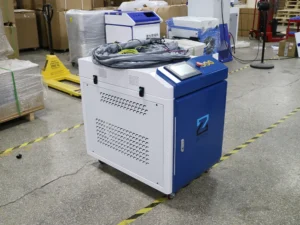مقدمة:
يوفر لحام الفولاذ المقاوم للصدأ العديد من المزايا، مما يجعله مثاليًا للعديد من التطبيقات. ومن أهم هذه المزايا متانته ومقاومته للتآكل. يمكن إنجاز لحام الفولاذ المقاوم للصدأ باستخدام طرق مختلفة. ولكل منها مزاياها واعتباراتها الخاصة. في تصنيع ومعالجة الفولاذ المقاوم للصدأ، أصبح اللحام بالليزر أمرًا حيويًا. كيف يتم لحام الفولاذ المقاوم للصدأ؟ ستستكشف هذه المقالة بعمق لحام الفولاذ المقاوم للصدأ.
كيفية لحام الفولاذ المقاوم للصدأ؟

1. لحام قوس الأرجون
عند لحام الفولاذ المقاوم للصدأ باستخدام قوس الأرجون، يتم تحقيق حماية جيدة. لا تحترق عناصر السبائك بسهولة، ومعامل الانتقال مرتفع. اللحام جيد التكوين، ولا يحتوي على غلاف خبث، وله سطح أملس. يتميز المفصل الملحوم بمقاومة عالية للحرارة وخصائص ميكانيكية جيدة. يستخدم لحام قوس التنغستن اليدوي على نطاق واسع في لحام قوس الأرجون. يتم استخدامه في لحام صفائح الفولاذ المقاوم للصدأ 0.5 ~ 3 مم. يكون تكوين سلك اللحام عمومًا هو نفسه تكوين اللحام. الغاز الواقي هو عمومًا الأرجون النقي الصناعي.
يجب أن تكون السرعة أثناء اللحام سريعة قدر الإمكان، وحاول تجنب التأرجح الجانبي. يمكن استخدام لحام القوس الانصهاري للفولاذ المقاوم للصدأ بسمك أكبر من 3 مم. يتميز لحام قوس الأرجون بإنتاجية عالية، ومنطقة صغيرة متأثرة بالحرارة في اللحام، وتشوه صغير في اللحام. يتمتع بمقاومة جيدة للتآكل ويسهل تشغيله تلقائيًا.
2. اللحام بالغاز
اللحام بالغاز مريح ومرن. يمكنه لحام اللحامات في مواقع مكانية مختلفة. يمكن استخدام اللحام بالغاز أحيانًا لأجزاء الفولاذ المقاوم للصدأ، مثل الهياكل ذات الألواح الرقيقة والأنابيب ذات الجدران الرقيقة. هذا بدون متطلبات مقاومة التآكل. يكون طرف اللحام أصغر عمومًا من اللحام بالفولاذ منخفض الكربون بنفس السُمك لمنع ارتفاع درجة الحرارة. يجب استخدام لهب اللحام بالغاز لهب محايد. يجب اختيار سلك اللحام وفقًا لتكوين وأداء اللحام.
الزاوية بين طرف الشعلة ومكان اللحام هي 40 إلى 50 درجة عند اللحام. يجب ألا تقل المسافة بين قلب اللهب وحوض المنصهر عن 2 مم. يكون طرف سلك اللحام على اتصال بحوض المنصهر ويتحرك على طول اللحام مع اللهب. لا يتأرجح شعلة اللحام جانبيًا. يجب أن تكون سريعة، وحاول تجنب الانقطاعات.
3. اللحام اليدوي
اللحام اليدوي هو طريقة لحام شائعة وسهلة الاستخدام. يضبط البشر طول القوس. يحدد حجم الفجوة بين قضيب اللحام وقطعة العمل ذلك. يمكن استخدام طريقة اللحام البسيطة هذه في لحام جميع المواد تقريبًا. يمكن تكييفها بسهولة للاستخدام في الهواء الطلق ولا تشكل مشكلة حتى عند استخدامها تحت الماء.
4. اللحام MIG/MAG
هذه طريقة لحام قوسي أوتوماتيكية محمية بالغاز. يتم حرق القوس بين سلك حامل التيار وقطعة العمل تحت درع غازي محمي. يعمل السلك الذي تغذيه الآلة كقضيب لحام ويذوب تحت قوسه. نظرًا لتعدد استخداماته وخصوصيته، فهو لا يزال طريقة اللحام الأكثر استخدامًا على مستوى العالم. يتم استخدامه للمواد الفولاذية وغير السبائكية والسبائك المنخفضة والمواد ذات السبائك العالية. يمكن أن تلبي MAG متطلبات ألواح الفولاذ الرقيقة بسمك 0.6 مم عند لحام الفولاذ. غاز الحماية المستخدم هنا هو غاز تفاعلي مثل ثاني أكسيد الكربون أو غاز مختلط. لحام MIG/MAG له القيد الوحيد. يجب حماية قطعة العمل من الرطوبة للحفاظ على تأثير الغاز عند اللحام في الهواء الطلق.
5. اللحام بالتنغستن
يتم توليد القوس بين سلك اللحام التنغستن المقاوم للحرارة وقطعة العمل. الغاز الواقي المستخدم هنا هو الأرجون النقي. السلك المغذي غير مكهرب. يمكن تغذية سلك اللحام يدويًا أو ميكانيكيًا. لا تتطلب بعض الاستخدامات المحددة تغذية السلك. تحدد المادة المراد لحامها ما إذا كان سيتم استخدام التيار المباشر أو المتناوب. يتم ضبط سلك اللحام التنغستن على القطب السالب عند استخدام التيار المباشر.
6. اللحام بالليزر

يتميز هذا اللحام بكفاءة عالية، ومدخلات حرارية منخفضة، وتكلفة منخفضة، وحماية للبيئة. تتميز طبقات اللحام بالليزر بأنها ناعمة وجميلة. حجم المعدن الملحوم صغير. وهو مناسب للأجزاء ذات متطلبات المظهر العالية.
عادةً ما يتم تصميم الطرف الأمامي لبندقية اللحام بفوهة توجيه ممتدة. أثناء اللحام، يمكن لطرف فوهة التوجيه أن يلتصق بقطعة العمل ويتحرك على طول شكل قطعة العمل. لا يحتاج المشغل إلى بذل جهد للتغلب على جاذبية بندقية اللحام نفسها، مثل اللحام القوسي اليدوي أثناء الاستخدام. يمكن تشغيله بيد واحدة. لذلك، فإن مستوى المهارة المطلوب من اللحامين منخفض. عادةً ما يستغرق اللحام من 5 إلى 7 أيام فقط لتعلم استخدامه بكفاءة من البداية. في ظل نفس الظروف، يحتاج اللحام القوسي اليدوي الماهر إلى 30 يومًا أو أكثر.
تم تحسين كفاءتها نوعيًا لقطع العمل الأكثر تعقيدًا مقارنة بلحام القوس اليدوي التقليدي. من حيث المرونة، يمكن تخصيص مسدس اللحام. يمكن تكييفه مع اللحام في مساحات صغيرة مختلفة. هذا هو الوضع حيث يمكن لحام اللحام القوسي اليدوي. يمكن أيضًا إجراء اللحام بالليزر المحمول.
الدور الرئيسي للحام الفولاذ المقاوم للصدأ بالليزر
-
لحام عالي الجودة
من خصائص الفولاذ المقاوم للصدأ متطلباته العالية للجودة. لذا، فإن لحام الفولاذ المقاوم للصدأ يتطلب طريقة عالية الدقة. يستخدم لحام الفولاذ المقاوم للصدأ بالليزر أشعة الليزر عالية الطاقة لتحقيق جودة لحام ممتازة. وهذا يضمن قوة وإحكام اللحام للمفاصل الملحومة. وهذا أمر بالغ الأهمية للتصنيع الذي يتطلب درجة عالية من مقاومة التآكل وإحكام الهواء. وتشمل هذه معدات معالجة الأغذية والأجهزة الطبية والحاويات الكيميائية.
-
تأثير حراري قليل
لحام الفولاذ المقاوم للصدأ بالليزر هو تقنية لحام بدون تلامس. لا يوجد تقريبًا أي نقل للحرارة إلى المواد المحيطة أثناء اللحام. وهذا يعني أن المنطقة المتأثرة بالحرارة في الفولاذ المقاوم للصدأ صغيرة. وهذا يقلل من خطر التشوه الحراري وخشونة الحبوب في منطقة اللحام. وهذا مهم للحفاظ على خصائص المواد ومظهر الفولاذ المقاوم للصدأ.
-
تصنيع عالي الكفاءة

ال آلة لحام الفولاذ المقاوم للصدأ بالليزر يتميز بدرجة عالية من الأتمتة وسرعة اللحام السريعة. ويمكنه إكمال مهام اللحام المعقدة في وقت قصير. وهذا يحسن كفاءة إنتاج منتجات الفولاذ المقاوم للصدأ ويقلل من تكاليف الإنتاج.
الاتجاه المستقبلي في اللحام بالليزر
-
اللحام الذكي والتكيفي
قد تكون تقنية اللحام بالليزر للفولاذ المقاوم للصدأ مجهزة بأنظمة تحكم أكثر ذكاءً. فهي تستخدم أجهزة استشعار وتكنولوجيا الذكاء الاصطناعي لتحقيق اللحام التكيفي. وهذا من شأنه تمكين الآلة من التكيف مع متطلبات تصميم منتجات الفولاذ المقاوم للصدأ المختلفة في الوقت الفعلي. وهذا يحسن دقة اللحام وكفاءته. وسوف تساعد خوارزميات التعلم الآلي في تحسين معلمات اللحام لتحقيق الأداء الأمثل.
-
لحام متعدد المواد
قد تستخدم منتجات الفولاذ المقاوم للصدأ في المستقبل مجموعة من المواد لتحسين الأداء والموثوقية. يمكن لآلات اللحام بالليزر للفولاذ المقاوم للصدأ التعامل مع أنواع مختلفة من السبائك المعدنية. وتشمل هذه سبائك الألومنيوم والنحاس والنيكل.
-
توفير الطاقة وحماية البيئة
يركز تصنيع الفولاذ المقاوم للصدأ بشكل متزايد على الاستدامة وحماية البيئة. ستولي تكنولوجيا اللحام المستقبلية المزيد من الاهتمام لكفاءة الطاقة. فهي تستخدم المزيد من مصادر الليزر الموفرة للطاقة وتقلل من توليد النفايات لتلبية متطلبات حماية البيئة.
خاتمة:
بشكل عام، تلعب تقنية اللحام بالليزر للفولاذ المقاوم للصدأ دورًا حاسمًا في تصنيع الفولاذ المقاوم للصدأ ومعالجته. فهي توفر أساسًا متينًا لمنتجات الفولاذ المقاوم للصدأ عالية الجودة. ومع تقدم التكنولوجيا، سيستمر اللحام بالليزر للفولاذ المقاوم للصدأ في لعب دور أساسي في مجالات مختلفة.
